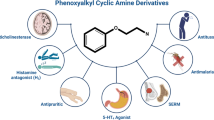Abstract
A comprehensive SAR study of a putative TLR 3/8/9 agonist was conducted. Despite the excitement surrounding the potential of the first small molecule TLR3 agonist with a compound that additionally displayed agonist activity for TLR8 and TLR9, compound 1 displayed disappointing activity in our hands, failing to match the potency (EC50) reported and displaying only a low efficacy for the extent of stimulated NF-κB activation and release. The evaluation of >75 analogs of 1, many of which constitute minor modifications in the structure, failed to identify any that displayed significant activity and none that exceeded the modest activity found for 1.











Similar content being viewed by others
References
Ferrandon D, Imler JL, Hoffmann JA. Sensing infection in Drosophila: Toll and beyond. Semin Immunol. 2004;16:43–53.
Janeway CA Jr, Medzhitov R. Innate immune recognition. Annu Rev Immunol. 2002;20:197–216.
Akira S, Uematsu S, Takuechi O. Pathogen recognition and innate immunity. Cell. 2006;124:783–801.
Moresco EM, LaVine D, Beutler B. Toll-like receptors. Curr Biol. 2011;21:R488–R493.
Kang JY, Lee JO. Structural biology of the Toll-like receptor family. Annu Rev Biochem. 2011;809:917–941.
Beutler B. Neo-ligands for innate immune receptors and the etiology of sterile inflammatory disease. Immunol Rev. 2007;220:113–128.
Kanzler H, Barrat FJ, Hessel EM, Coffman RL. Therapeutic targeting of innate immunity with Toll-like receptor agonists and antagonists. Nat Med. 2007;13:552–559.
Hennessy EJ, Parker AE, O’Neill LA. Targeting Toll-like receptors: emerging therapeutics? Nat Rev Drug Discovery. 2010;9:293–307.
Connolly DJ, O’Neill LA. New developments in Toll-like receptor targeted therapeutics. Curr Opin Pharmacol. 2012;12:510–518.
Rakoff-Nahoum S, Medzhitov R. Toll-like receptors and cancer. Nat Rev Cancer. 2009;9:57–63.
Hoebe K, Jiang Z, Georgel P, Tabeta K, Janssen E, Du X, Beutler B. TLR signaling pathways: opportunities for activation and blockade in pursuit of therapy. Curr Pharmaceut Des. 2006;12:4123–4134.
Czarniecki M. Small molecule modulators of Toll-like receptors. J Med Chem. 2008;51:6621–6626.
Meyer T, Stockfleth E. Clinical investigations of Toll-like receptor agonists. Expert Opin Invest Drugs. 2008;17:1051–1065.
Wang X, Smith C, Yin H. Targeting Toll-like receptors with small molecule agents. Chem Soc Rev. 2013;42:4859–4866.
Peri F, Calabrese V. Toll-like receptor 4 (TLR4) modulation by synthetic and natural compounds: An update. J Med Chem. 2014;57:3612–3622.
Lu BL, Williams GM, Brimble MA. TLR2 Agonists and their structure–activity relationships. Org Biomol Chem. 2020;18:5073–5094.
Federico S, Pozzetti L, Papa A, Carullo G, Gemma S, Butini S, Campiani G, Relitti N. Modulation of the innate immune response by targeting Toll-like receptors: a perspective on their agonists and antagonists. J Med Chem. 2020;63:13466–13513.
Hajishangallis G, Lambris JD. More than complementing Tolls: complement–Toll-like receptor synergy and crosstalk in innate immunity and inflammation. Immunol Rev. 2016;274:233–244.
Zhang L, Dewan V, Yin H. Discovery of small molecules as multi-Toll-like receptor agonists with proinflammatory and anticancer activities. J Med Chem. 2017;60:5029–5044.
Wang Y, Su L, Morin MD, Jones BT, Whitby LR, Surakattula MM, Huang H, Shi H, Choi JH, Wang KW, Moresco EM, Berger M, Zhan X, Zhang H, Boger DL, Beutler B. TLR4/MD-2 activation by a synthetic agonist with no similarity to LPS. Proc Natl Acad Sci USA. 2016;113:E884–E893.
Morin MD, Wang Y, Jones BT, Su L, Surakattula MM, Berger M, Huang H, Beutler EK, Zhang H, Beutler B, Boger DL. Discovery and structure-activity relationships of the neoseptins: a new class of Toll-like receptor-4 (TLR4) agonists. J Med Chem. 2016;59:4812–4830.
Morin MD, Wang Y, Jones BT, Mifune Y, Su L, Shi H, Moresco EMY, Zhang H, Beutler B, Boger DL. Diprovocims: a new and exceptionally potent class of toll-like receptor agonists. J Am Chem Soc. 2018;140:14440–14454.
Su L, Wang Y, Wang J, Mifune Y, Morin MD, Jones BT, Moresco EMY, Boger DL, Beutler B, Zhang H. Structural basis of TLR2/TLR1 activation by the synthetic agonist diprovocim. J Med Chem. 2019;62:2938–2949.
Wang Y, Su L, Morin MD, Jones BT, Mifune Y, Shi H, Wang K, Zhan X, Liu A, Wang J, Li X, Tang M, Ludwig S, Hildebrand S, Zhou K, Siegwart D, Moresco EMY, Zhang H, Boger DL, Beutler B. Adjuvant effect of the novel TLR1/2 agonist Diprovocim synergizes with anti-PD-L1 to eliminate melanoma in mice. Proc Natl Acad Sci USA. 2018;115:E8698–E8706.
Alexopoulou L, Holt AC, Medzhitov R, Flavell RA. Recognition of double-stranded RNA and activation of NF-kappaB by Toll-like receptor 3. Nature. 2001;413:732–738.
Ohto U, Ishida H, Shibata T, Sato R, Miyake K, Shimizu T. Toll-like receptor 9 contains two DNA binding sites that function cooperatively to promote receptor dimerization and activation. Immunity. 2018;48:649–658.e4.
Choe J, Kelker MS, Wilson IA. Crystal structure of human toll-like receptor 3 (TLR3) ectodomain. Science. 2005;309:581–585.
Bissantz C, Kuhn B, Stahl M. A medicinal chemist’s guide to molecular interactions. J Med Chem. 2010;53:5061–5084.
Acknowledgements
We gratefully acknowledge the financial support of NIH (CA042056, DLB) and Bristol Myers Squibb.
Author information
Authors and Affiliations
Corresponding author
Ethics declarations
Conflict of interest
The authors declare no competing interests.
Additional information
Dedication: This article is dedicated to Professor Gary Grunewald, a treasured longtime friend and early colleague alongside which I had the pleasure of working for many years.
Publisher’s note Springer Nature remains neutral with regard to jurisdictional claims in published maps and institutional affiliations.
Supplementary information
Rights and permissions
About this article
Cite this article
Sarkar, A., Kankanamalage, A.C.G., Zhang, Q. et al. Synthesis, structure-activity relationship studies and evaluation of a TLR 3/8/9 agonist and its analogues. Med Chem Res 30, 1377–1385 (2021). https://doi.org/10.1007/s00044-021-02736-3
Received:
Accepted:
Published:
Issue Date:
DOI: https://doi.org/10.1007/s00044-021-02736-3




